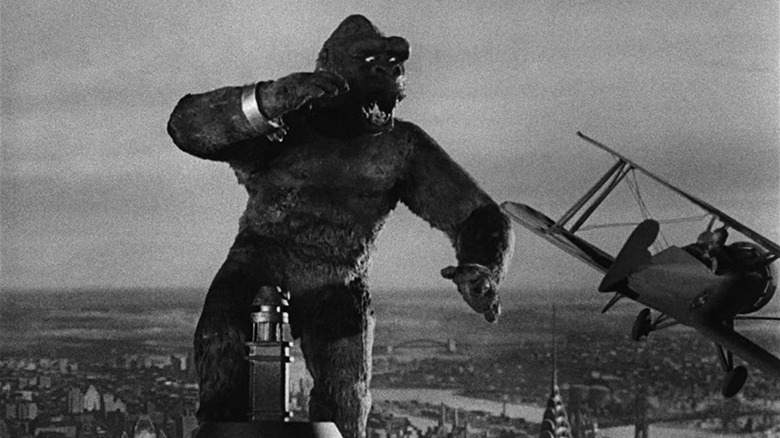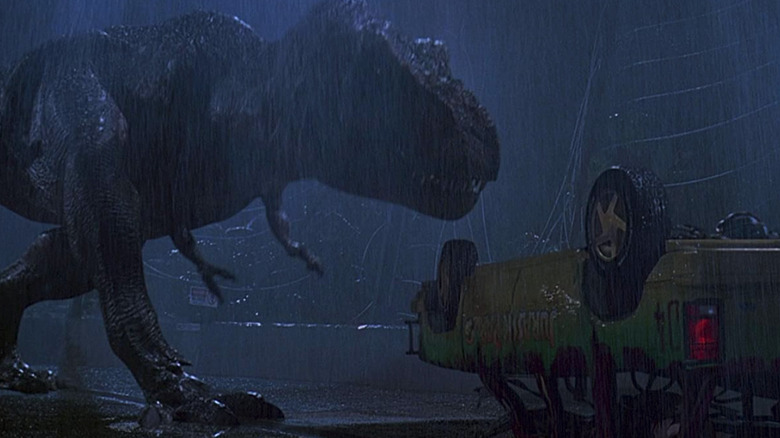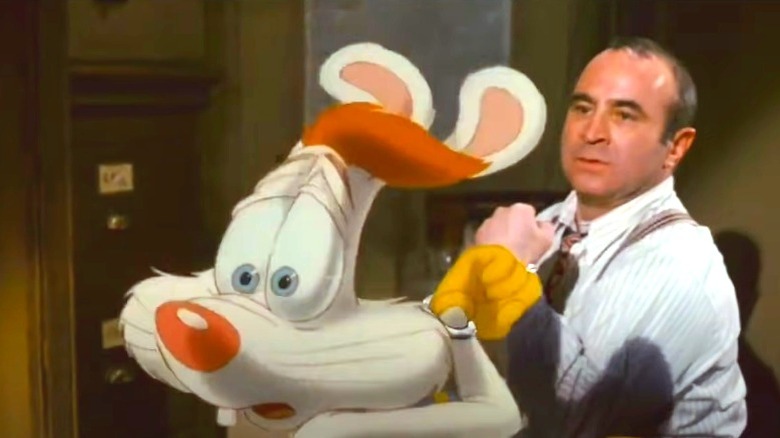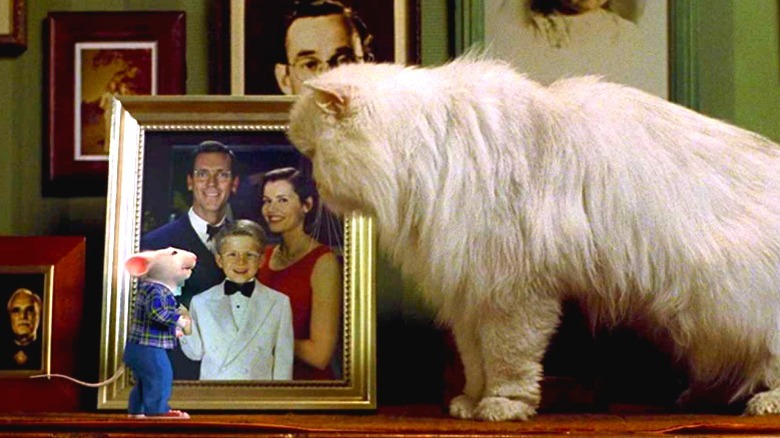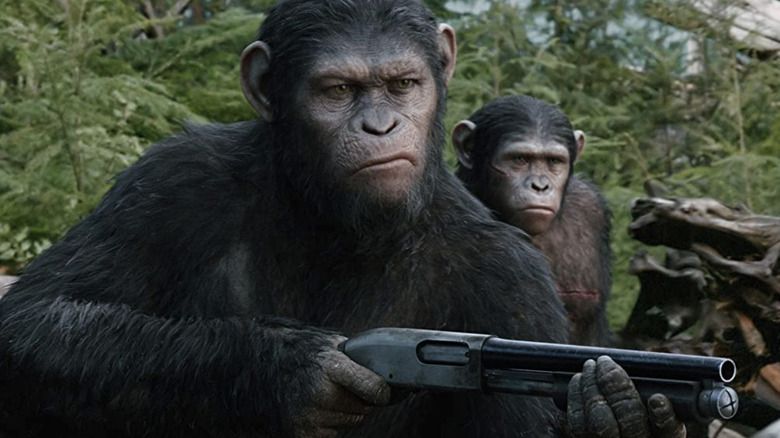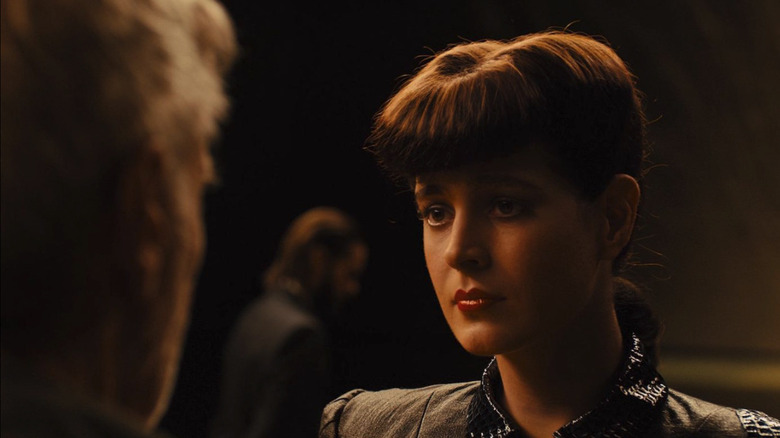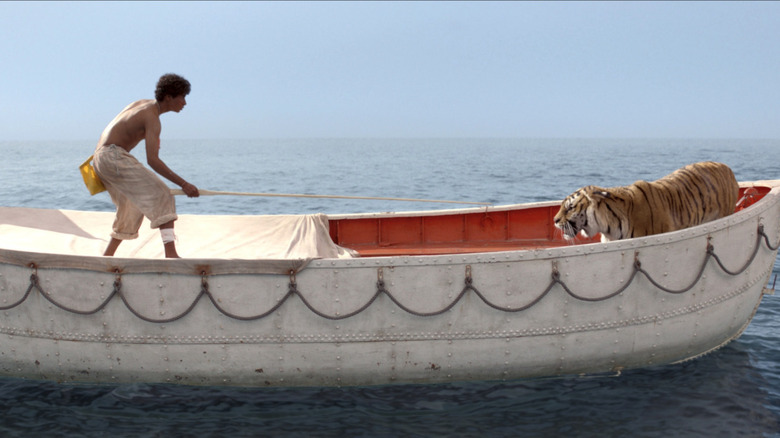The 15 Most Influential VFX Artists In Movie History
Cinema as we know it wouldn't be possible without a myriad of technologies and techniques. Visual effects (VFX) are not to be confused with special effects (SFX), though they sometimes go hand-in-hand. Both affect what you see on-screen in different ways. Special effects, such as animatronics, make-up and prosthetics, and physical elements like rain, snow, or explosions, are those practical effects that are coordinated on set. Visual effects are elements added to the film when practical effects are impossible (or too difficult) to achieve. Both visual and special effects evolved side by side before technology more clearly defined them as separate. Computer-generated images eventually became a staple of visual effects.
Manipulating images is hardly new, though film presents its own set of difficulties. Major strides in visual effects started happening in the 1930s with multiple artists experimenting with their imaginations' limits by superimposing puppets and environments onto live-action footage and developing new tools and techniques to create fantastical moving images. From "King Kong" to "Star Wars," the field of visual effects is one of immense creativity and impressive technical ability. Here are 15 visual effect artists that influenced modern film.
Willis O'Brien
Willis O'Brien was a pioneer of stop-motion animation, one of the first techniques used in visual effects before animatronics and computer-animated monsters became the norm. Stop-motion requires time and skill, but the technology was (and remains) pretty simple. O'Brien didn't create the technique, but he did improve it and bring it into mainstream cinema. He had multiple careers in his early years, working as a cartoonist and a sculptor. Those jobs helped him to become a stop-motion animator and visual and special effects artist later on. He started out using clay for his creatures, moving on to armatures covered with flexible rubber skin. To increase the realism of his puppets, he added inflatable bladders underneath to mimic breathing.
O'Brien is mostly known for his work on the classic 1933 horror film, "King Kong," including the famous scene of the giant ape climbing to the top of the Empire State Building. He also worked on other classics like "The Lost World" and "Mighty Joe Young." O'Brien was a mentor to many other visual effects artists, including Ray Harryhausen and Marcel Delgado.
Marcel Delgado
Mexican sculptor Marcel Delgado had little interest in filmmaking at first. After his family relocated to Los Angeles, he began studying at the Otis Art Institute, where he met Willis O'Brien. The visual effects pioneer invited Delgado to work in his studios. According to a lengthy interview with film critic Jim Lane, Delgado refused multiple times to work with O'Brien until the stop-motion master brought him to the studios. Delgado was blown away by the possibilities and took the job on the spot.
Delgado and O'Brien's collaboration spawned multiple groundbreaking special effects techniques. As a sculptor, Delgado's work focused mainly on miniatures and puppets, and he helped O'Birnef create techniques to give those puppets life-like qualities. Delgado collaborated on famous projects of O'Brien's like "The Lost World," "King Kong," and "Mighty Joe Young." He also went on to work in visual effects and special effects on other famous films such as "Mary Poppins," The Wizard of Oz," and "The Birds." Unfortunately, most of his work was uncredited.
Ray Harryhausen
Ray Harryhausen was another of Willis O'Brien's proteges. He started working in stop-motion animation and special effects when he was quite young and worked with O'Brien on films such as "Mighty Joe Young." Harryhausen then went on to produce his own projects, creating more ambitious creatures with every new film. Some of his most iconic sequences include the fighting skeletons of "Jason and the Argonauts" and fantastic creatures such as the Kraken and Medusa in "Clash of the Titans."
Harryhausen kept expanding the scope and quality of the techniques O'Brien pioneered and became a visual effects innovator himself. He created a new technique called "Dynamation," which involved filming stop-motion miniatures on a minimal painted set, a glass pane with blacked-out portions, and a screen projection from the back to create the special effects. The resulting footage would then be re-exposed to include live-action footage. He eventually received a career Academy Award for technical achievement in 1992 for his contributions to the art of visual effects.
Douglas Trumbull
Douglas Trumbull started as an illustrator and artist, working on photorealistic images for an animation and graphics studio called Graphic Films. His work got noticed by none other than Stanley Kubrick, who hired him to help with visual special effects for his epic sci-fi film, "2001: A Space Odyssey." Trumbull worked on sequences such as the Star Gate and the set of the supercomputer, Hal 9000.
He then went on to work on more sci-fi films, including "Star Trek: The Motion Picture," Steven Spielberg's "Close Encounters of the Third Kind," and Ridley Scott's "Blade Runner." Trumbull was behind many iconic scenes which reshaped sci-fi and cinema. He also directed "Silent Running" and "Brainstorm" but decided to quit the film industry shortly after the latter to focus on building and refining new tools and techniques. All of his work relied on practical effects, and he has several patents to his name. He also helped bring IMAX to the mainstream.
Dennis Muren
Did you know that visual effects artists can get stars on the Hollywood Walk of Fame? In 1999, Dennis Muren was the first to receive that honor for his important contributions to the field. He has won nine Oscars throughout his career, as well as many other accolades. Muren got his start on an indie film called "Equinox," which he self-produced with two friends. The film and its creative effects landed Muren a job at the newly-founded Industrial Light and Magic (ILM) in 1976, where he went on to work on the very first "Star Wars" movie.
Muren has been with ILM for over 45 years and participated in the special effects of many blockbusters such as "Battlestar Galactica," "E.T. The Extra-Terrestrial," and "Terminator 2: Judgment Day." He was also instrumental in the industry's move from traditional to digital effects, having worked on some of the first computer-generated effects with "Jurassic Park."
Kenneth Ralston
Kenneth Ralston is another visual effects artist who started his career in the film industry on "Star Wars." Dennis Muren hired him as a camera assistant, but they'd worked together before at Cascade Pictures, a commercial animation and special effects company. Ralston worked at George Lucas' Industrial Light and Magic with Muren for about two decades before moving on to Sony Pictures Imageworks, where he started a fruitful collaboration with director Robert Zemeckis.
Ralston developed a unique work relationship with Zemeckis, collaborating with him on 10 films, including the "Back to the Future" trilogy, "Forrest Gump," "Jumanji," and "Death Becomes Her." He is also behind the impressive effects of "Who Framed Roger Rabbit," which was an unexpected marriage of traditional cell animation, technical effects, and live action. He has won multiple Academy Awards for his work, including a special achievement Oscar for the visual effects in 1983's "Return of the Jedi."
John Dykstra
John Dykstra got his start on Douglas Trumbull's "Silent Running" before joining the "Star Wars" crew, where he worked on a motion-control camera rig. The resulting rig, named Dykstraflex after its inventor, was the first digital motion control photography camera system. He was also one of the founding members of ILM, but he later moved on to other projects, working with a lot of different studios with his company Apogee Film Effects. Dykstra's work includes such films as "Star Trek: The Motion Picture," "Batman Forever," and "Stuart Little."
Dykstra worked on comic books films in the aughts. He was the visual effects designer on Sam Raimi's "Spider-Man" and "Spider-Man 2" and was behind such stunning effects as Spidey's web-slinging jaunts across New York and Doc Ock's sentient tentacles. His work on the second film even earned him an Academy Award. Dykstra also worked on the X-Men films "First Class," "Apocalypse," and "Dark Phoenix."
John Gaeta
John Gaeta is a visual effects visionary and inventor who's best known for his work on "The Matrix" series. He was behind the effect known as "bullet time," which was an impressive feat featured in the first film of the series. The most famous bullet-time sequence is an intricate shot in which Neo (Keanu Reeves) dodges bullets in slow motion on a rooftop.
Gaeta held a variety of jobs, including working as part of "Saturday Night LIve's" film unit, before landing his first big movie, "Star Trek V: The Final Frontier." He went on to work with visual effects master Douglas Trumbull at his studio, The Trumbull Company, prior to collaborating with the Wachowskis on "The Matrix" and "Speed Racer," for which he pioneered many new special effects techniques and technologies. Gaeta is always pushing the frontiers of visual and special effects. His later projects include the augmented and virtual reality "Star Wars" installations with the ILMxLAB, a division of Lucasfilm and Disney where he acted as executive creative director.
Joe Letteri
Another giant in the field is Joe Letteri. He is one of the artists responsible for bringing motion and performance capture to the foreground of visual effects. He has worked with Andy Serkis to bring his performances as Gollum in "The Lord of the Rings" and "The Hobbit" trilogies and Ceasar in the "Planet of the Apes" films to digital life. He's also known for his work on James Cameron's "Avatar" and its upcoming sequels. Letteri has received numerous accolades for his work, including four Academy Awards.
Letteri started his career as a math and computer nerd with an interest in the science behind computer-generated graphics. After working on graphics for commercials and news, he moved on to ILM for a few years, where his first project was to help craft the opening shot for "Star Trek VI: The Undiscovered Country." From there, he worked on other big ILM projects such as "Jurassic Park," "Casper," and "Mission: Impossible." He then moved on to Wētā Ltd., where he worked on titles like "X-Men: First Class," "The Adventures of Tintin," and "The Jungle Book."
John Knoll
John Knoll started as a model maker before becoming a visual effects artist, but it may be surprising to learn that he's also one of the inventors behind Adobe Photoshop, one of the leading graphic and digital art editors in the world, which he developed with his brother. Yet another surprising fact: Knoll isn't only a skilled visual effects artist and developer, he's also a passionate "Star Wars" fan. He even pitched the original idea for the stand-alone "Star Wars" film, "Rogue One."
He joined ILM in 1986, where he still works to this day. He's worked on several big sci-fi franchises such as "Star Wars" and "Star Trek," as well as the "Pirates of the Caribbean" trilogy, and he pioneered several visual effects techniques throughout the decades. Knoll's work has been nominated for several honors, and he was awarded a scientific and engineering Academy Award in 2019 for his development of Photoshop and an Oscar for best achievement in visual effects for "Pirates of the Caribbean: Dead Man's Chest."
John Nelson
Working first as a cameraman, John Nelson became interested in computer graphics and started doing some digital animation and visual effects. After working at Mental Images, a Berlin-based software company, he moved on to computer-generated visual effects full time. His first big titles were "Terminator 2" and "Gladiator," for which he won an Oscar for his work in digitally recreating Rome's grandeur, including the Colosseum and its teeming crowds.
His resume also includes films such as "The Matrix Reloaded" and "Revolutions," "I, Robot," "Iron Man," and "World War Z." His most recent project was Denis Villeneuve's "Blade Runner 2049," a sequel to Ridley Scott's original 1982 cyberpunk sci-fi classic. Along with creating the film's impressive futuristic cityscapes, Nelson's work in bringing back Sean Young's replicant character, Rachael, and merging the characters of Joi (Ana de Armas) and Mariette (Mackenzie Davis), earned him his second Oscar for best achievement in visual effects.
Roger Guyett
Another ILM giant who's been working with the famous visual effects company for almost three decades is Roger Guyett. His first project was "Casper," working on the team which brought about the very first 3D-animated character in a leading role. He was also involved in films such as "Rent," "Harry Potter and the Prisoner of Azkaban," and "Mars Attacks!" Guyett has been nominated and honored several times for his work, including for helping bring D-Day to life on the screen for Spielberg's World War II epic, "Saving Private Ryan." Most recently, he worked on "Ready Player One" and the latest "Star Wars" trilogy.
Guyett developed a great working relationship with director J.J. Abrams, with whom he collaborated on both "Star Trek" and "Star Wars. The marriage of special and visual effects is important to Guyett, and traveling to locations and using practical effects such as puppets is an integral part of his process.
Paul J. Franklin
Although he initially studied fine arts, Paul J. Franklin started working in film as a videotape editor before growing interested in computer graphics and animation. After a detour working in video games as a computer artist, he founded the now-massive visual effects company Double Negative with colleagues in 1998. He's worked on blockbusters such as "The DaVinci Code," "Harry Potter and the Order of the Pheonix", "Harry Potter and the Half-Blood Prince," "Captain America: Civil War," and both "Venom" movies.
He's another visual effects artist who has a close relationship with one director in particular. Franklin has collaborated on several films with Christopher Nolan, including the "Dark Knight" trilogy, "Inception" and "Interstellar." He won Oscars for his work on the latter two films. He's not only a visual effects artist. He's also a talented filmmaker. In 2017, Franklin wrote and directed the sci-fi short film "The Escape."
Paul Lambert
In 2022, Paul Lambert won an Oscar for his work on Denis Villeneuve's "Dune." It was his third time winning the coveted award. He also won for his work on "First Man" and "Blade Runner 2049" alongside the previously mentioned John Nelson. Lambert has been in the industry for over two decades and has worked on films such as "Mission: Impossible II," Lara Croft: Tomb Raider," "The Curious Case of Benjamin Button," and "TRON Legacy" to name only a few.
Lambert is also an inventor. He created a tool called the Image-Based Keyer (IBK) for the digital compositing and visual effects software Nuke. IBK is still used to this day as the industry standard for working with blue and green screens. However, Lambert has his eyes on the future. With artificial intelligence being implemented more and more into visual effects technology, he admits to using some new AI-based tools while working on "Dune."
Bill Westenhofer
Like many other visual effects artists on this list, Bill Westenhofer marries art and technology in his work. He has a master's degree in computer science, which he earned by studying the use of dynamics in physically-based animation. He began working as a digital artist for the now-defunct Rhythm and Hues Studios on projects such as "Stuart Little," "Elf," "The Golden Compass," and "The Chronicles of Narnia: The Lion, the Witch and the Wardrobe."
After he left in 2013, he joined other big projects like "Life of Pi" and "Wonder Woman." On "Gemini Man," he worked on de-aging Will Smith's face for his character, Junior. He's won two Oscars for his work on the films "The Golden Compass" and "Life of Pi." His acceptance speech for the latter, however, caused a stir. Westenhofer was cut off as he was addressing the state of the industry, which he later stated views workers in visual effects as technicians and button-pushers instead of artists.
